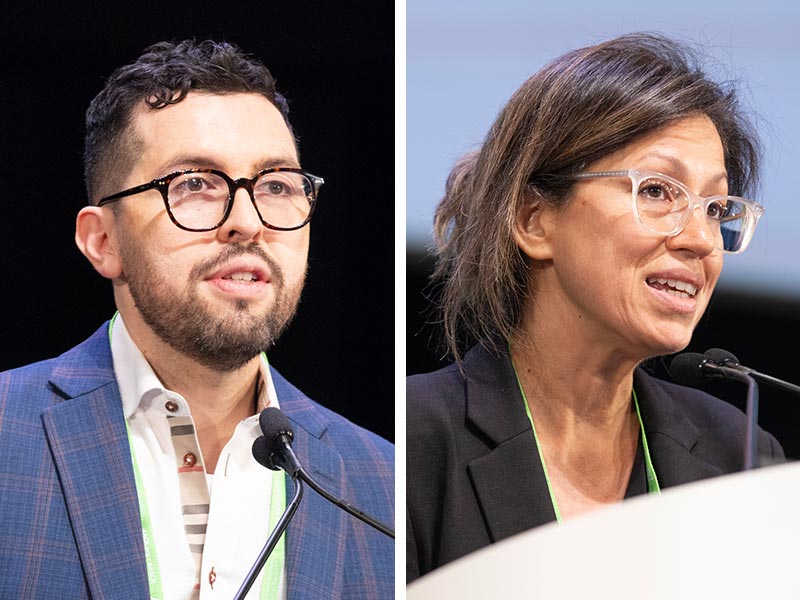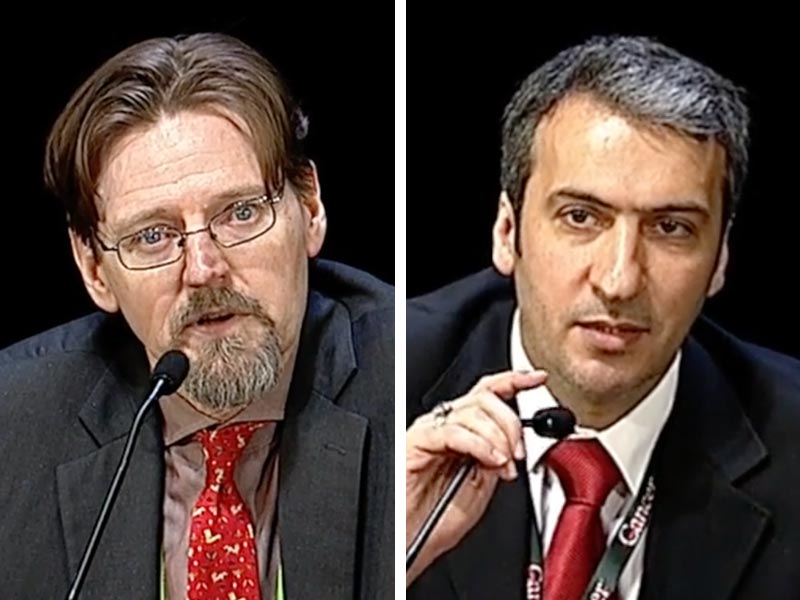Cutting-edge immunotherapies headline fourth Clinical Trials Plenary

Chaired by Jedd D. Wolchok, MD, PhD, FAACR, of Weill Cornell Medicine, and Crystal Mackall, MD, FAACR, of Stanford University, the Biologics and T-cell Engagers Clinical Trials Plenary Session featured updates on four exciting immune-based approaches.
Reflecting that the last time he spoke on stage in the McCormick Convention Center’s Arie Crown Theatre was in 2013 when he revealed the results of the first trial testing dual PD-1 and CTLA-4 checkpoint immunotherapy, Wolchok framed Tuesday’s session as “an opportunity for us to think about how much change there has been in the use of immunotherapy agents to treat an ever-lengthening list of malignancies” while also acknowledging that there is more work to do.
Conditional CD40 agonism in MUC1-high bladder cancer
Juan C. Osorio, MD, of Memorial Sloan Kettering Cancer Center (MSKCC), shared data from a phase I trial evaluating an Fc receptor-optimized antibody designed to stimulate the CD40 immune signaling pathway in patients with non-muscle invasive bladder cancer that did not respond to Bacillus Calmette-Guérin vaccine.

At six months, 38% of patients experienced complete tumor elimination, which was linked to enrichment of dendritic cells and both CD4-positive and CD8-positive T cells. Osario speculated that this immune triad may provide the foundation for the formation of the mature tertiary lymphoid structures observed in responders.
HER2 T-cell engager combination in breast cancer
Osario’s MSKCC colleague Shanu Modi, MD, next presented results from a phase Ia/b study evaluating runimotamab, a bispecific T cell-engaging antibody that simultaneously targets HER2 and CD3, in patients with HER2-positive breast cancer.
While runimotamab monotherapy did not promote antitumor activity, combining it with the first-generation HER2 antibody trastuzumab led to tumor regression—roughly 30% of patients’ tumors responded—and improved safety and tolerability.
Bispecific targets T-cell receptor beta and IL-2
Ryan J. Sullivan, MD, of Massachusetts General Hospital, discussed a phase I/II trial involving invikafusp alfa, a first-in-class dual T-cell agonist that targets T-cell receptor beta chain and the interleukin-2 (IL-2) receptor.

In patients with antigen-rich solid tumors resistant to PD-L1 immunotherapy, the bispecific antibody led to a 61% disease control rate and a 52% tumor shrinkage rate across several types of cancer, including cervical, colorectal, head and neck, and lung cancer, as well as melanoma. Importantly, treatment led to a potent and selective expansion of a subset of CD8-positive T cells that went on to acquire a novel “memory-like effector phenotype” in both the tumor and blood.
Trackable ICAM-1 CAR T cells in thyroid cancer
The last presentation was from Samer A. Srour, MD, of The University of Texas MD Anderson Cancer Center, who revealed results from a phase I trial in which patients with anaplastic and poorly differentiated thyroid cancers received AIC100, an ICAM-1-targeting CAR T-cell therapy.
Among the first nine patients treated with these CAR T cells, which could be tracked within the body via DOTATATE PET imaging thanks to their coexpression of the somatostatin receptor 2, two experienced clinical responses, one complete and one partial.
The recording of the full session is available for registered Annual Meeting attendees through October 2025 on the virtual meeting platform.
More from the AACR Annual Meeting 2025
View a photo gallery of scenes from Chicago, continue the conversation on social media using the hashtag #AACR25, and read more coverage in AACR Annual Meeting News.

